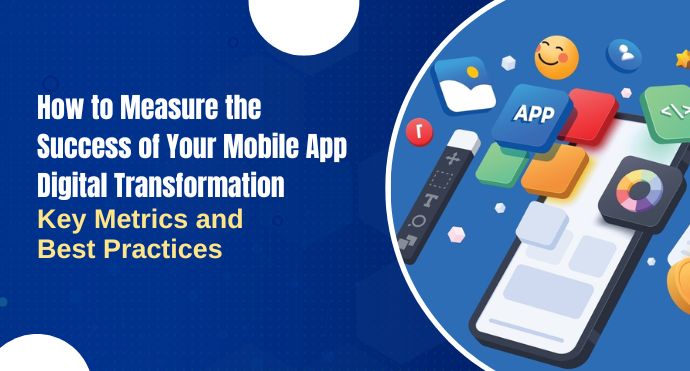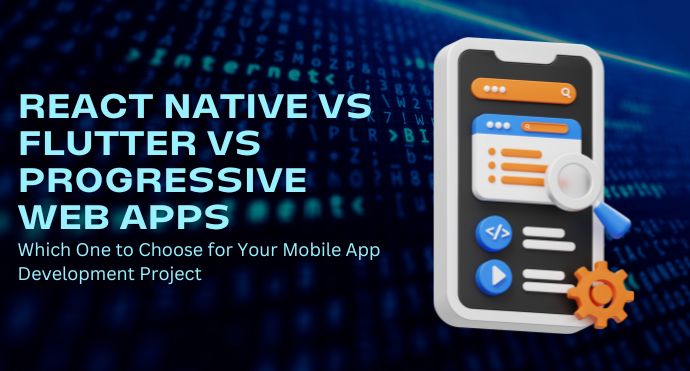Mobile app digital transformation is the process of using technology to modify and improve the way businesses create and manage their mobile applications and services. In today’s technological age, digital transformation is critical for businesses to remain competitive, especially in the mobile app space. However, it’s not enough to just go through the motions of implementing mobile app digital transformation; measuring the success of these efforts is equally important.
Measuring the success of mobile app digital transformation is critical for businesses to determine if their investments are worth the effort. It’s important to understand if the changes you’ve implemented have led to an increase in retention, engagement, revenue and more. Without gathering data and understanding how successful these changes are, you may fail to make informed decisions and optimize your mobile apps. In short, measuring success is necessary to improve what is already working and fix what isn’t. As the popular saying goes, “what gets measured gets managed.” So, measuring the success of mobile app digital transformation is essential in ensuring the longevity of your business.
The importance of measuring success for mobile app digital transformation cannot be overemphasized. It helps in setting realistic expectations, determining the effectiveness of the transformation, and identifying areas for improvement. In this blog, we’ll explore key metrics for measuring success, best practices for measuring success, limitations and challenges, and more. So, join us as we dive deeper into how to measure the success of your mobile app digital transformation.
Key Metrics for Measuring Success
So, you’ve invested in a mobile app digital transformation, but how do you know if it’s successful? Measuring and evaluating your mobile app’s success is essential to determine whether it’s meeting your business goals and expectations. In this section, we’ll explore key metrics to help you measure the success of your mobile app’s digital transformation.
User Acquisition
Attracting new users is critical to the success of your mobile app’s digital transformation. Measuring user acquisition requires tracking the number of downloads, installs, and registrations. Monitoring user acquisition metrics enables you to identify the sources that drive the most traffic and optimize your marketing strategies accordingly.
Retention Rate
User retention is the ability of your app to keep users engaged over time. Measuring the retention rate can help you understand the stickiness of your app and the frequency of users returning to your app after their first visit. A high retention rate indicates users find value in your product, while a low retention rate means there’s a need to improve your app experience.
User Engagement
Measuring user engagement helps you understand the quality of user experience within your app. User engagement metrics include session length, frequency, and duration. Engaged users spend more time within your app, perform more activities, and are more likely to make purchases.
App Ratings and Reviews
App ratings and reviews are important measures of user satisfaction and the overall quality of your app experience. High ratings and positive reviews not only attract new users but also help retain existing ones. Understanding user feedback by analyzing app reviews can also help improve the overall user experience.
Revenue
Your app’s success is ultimately determined by its ability to generate revenue. Measuring revenue helps you identify the profitability of your app and the impact of your digital transformation on your bottom line. Revenue metrics include in-app purchases, subscriptions, and advertising revenue.
Cost Per Acquisition
Measuring cost per acquisition (CPA) tracks the amount of money spent on acquiring each user. This can help you optimize your marketing budget and allocate resources to the channels that drive the most traffic and conversions. A low CPA indicates efficient use of resources, while a high CPA means you need to adjust your acquisition strategy.
Lifetime Value of a User
Measuring the lifetime value (LTV) of a user can help you understand the long-term value of a user to your app. LTV metrics include revenue generated per user, the number of sessions, and the duration of the app user lifecycle. Understanding LTV helps you identify opportunities to increase app revenue, improve retention, and acquire new users.
In conclusion, measuring the success of your mobile app digital transformation is crucial to ensure you achieve your business goals and objectives. By monitoring key metrics such as user acquisition, retention rate, user engagement, app ratings and reviews, revenue, cost per acquisition, and lifetime value of a user, you can make data-driven decisions to optimize your app experience and maximize business outcomes.
Best Practices for Measuring Success
So, you have developed a mobile app and undergone digital transformation to reinvent your traditional business model. You now have a clear vision of what you want to achieve and have identified the key performance indicators (KPIs) that will reflect your progress and results. Now what? How do you ensure that your mobile app digital transformation is successful? Here are some best practices for measuring success:
Establish Clear Goals and KPIs
The first and most crucial step to measure the success of your mobile app digital transformation is to establish clear goals and KPIs. Your goals should be specific, measurable, achievable, relevant, and time-bound (SMART). You can track various success metrics, including but not limited to user acquisition, retention rate, user engagement, app ratings and reviews, revenue, cost per acquisition, and lifetime value of a user.
Setting clear goals and KPIs will help you identify and prioritize the metrics that matter most to your business and align your mobile app digital transformation efforts with your overall business objectives. Furthermore, it will keep you focused on achieving business outcomes that are critical to your success.
Track Metrics Regularly
Once you have established clear goals and KPIs, the next step is to track your metrics regularly. Tracking your metrics regularly will help you identify patterns and trends in your mobile app digital transformation data that signal potential issues. It will also help you stay on top of performance issues as they arise.
However, tracking your metrics religiously doesn’t mean that you should spend all of your time on it. Instead, you should focus your attention on the metrics that matter most to your business and avoid getting bogged down in minute details.
Utilize Analytics Tools
To track your metrics effectively, you need to utilize analytics tools. Analytics tools enable you to collect, process, and analyze data from various sources in real time. With analytics tools, you can uncover hidden insights, make data-driven decisions, and optimize your mobile app digital transformation efforts for better outcomes.
There are a plethora of analytics tools available that can help you make sense of your mobile app digital transformation data. Some of the most popular analytics tools are Google Analytics, Mixpanel, App Annie, and Flurry.
Compare Performance Against Benchmarks
Measuring your mobile app digital transformation performance against the benchmarks of your competitors is a great way to gauge how well you are doing and how much progress you have made. Benchmarks are industry standards that help you understand how you are competing in the market.
Comparing your performance to the benchmarks can help you identify your strengths and weaknesses, develop new strategies, and make data-driven decisions that can have a significant impact on your business outcomes.
Listen to User Feedback
Listening to user feedback is critical to measuring the success of your mobile app digital transformation. User feedback can provide you with valuable insights into how well your mobile app is performing and how your customers are interacting with your product.
User feedback can include several aspects, such as app reviews, ratings, feedback forms, social media channels, and in-app surveys. By analyzing user feedback, you can identify areas for improvement, optimize your mobile app digital transformation efforts, and gain a competitive advantage.
Make Data-Driven Decisions
The final step to measuring the success of your mobile app digital transformation is to make data-driven decisions. Data analytics enables you to analyze your data, find patterns, and uncover insights that you can use to make informed decisions.
To make data-driven decisions, you need to have a clear understanding of your mobile app digital transformation data, interpret the results accurately, and communicate the findings effectively. Data-driven decisions are critical to the success of your mobile app digital transformation, and they can help you identify patterns, make informed decisions, and improve your business outcomes.
Measuring the success of your mobile app digital transformation is critical to ensuring that your efforts are generating positive outcomes. To measure the success of your mobile app digital transformation, you need to establish clear goals and KPIs, track metrics regularly, utilize analytics tools, compare performance against benchmarks, listen to user feedback, and make data-driven decisions. By adopting these best practices, you can ensure that your mobile app digital transformation is a success and provides your business with the competitive advantage it needs to succeed.
Limitations and Challenges
Despite the numerous benefits that mobile app digital transformation brings, tracking and measuring success can be challenging due to several limitations. These limitations can impede the ability of businesses to make data-driven decisions and potentially lead to inaccurate assessments of their mobile app digital transformation efforts.
One of the main limitations includes inaccurate data. Businesses need to ensure the accuracy and reliability of the data they collect to make informed decisions. Any data that is compromised, incomplete or poorly managed can lead to misleading results.
Another challenge faced while measuring success is setting clear goals and KPIs. Since digital transformation is a never-ending process, businesses need to establish clear goals and KPIs to measure success. This task can be daunting since the goals and KPIs will need to evolve and adapt to changing market conditions, customer preferences and emerging technologies.
The emergence of new metrics is another challenge. New trends and metrics emerge over time regularly, which can make it challenging to determine which metrics to use. This leads to confusion and inconsistency in measuring success.
Finally, there are also privacy concerns associated with tracking data, and businesses need to ensure they are compliant with all relevant regulations while still collecting and analyzing data.
Therefore, businesses need to be aware of these limitations while measuring success so that they can be addressed and overcome. It’s essential to strike a balance between data collection and privacy concerns to ensure that mobile app digital transformation is successful.
Conclusion
In conclusion, measuring the success of your mobile app digital transformation is crucial to ensure that your efforts are paying off. By tracking key metrics such as user acquisition, retention rate, user engagement, and revenue, you can establish clear goals and KPIs, utilize analytics tools, and make data-driven decisions.
Listening to user feedback, comparing performance against benchmarks, and navigating limitations and challenges such as inaccurate data and privacy concerns can also help you measure the success of your digital transformation. With these best practices in mind, you can ensure that your mobile app is optimized for success, driving innovation, competitiveness, and customer satisfaction.



